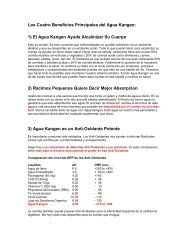ACID-ALKALINE BALANCE: ROLE IN CHRONIC ... - My Kangen Tools
ACID-ALKALINE BALANCE: ROLE IN CHRONIC ... - My Kangen Tools
ACID-ALKALINE BALANCE: ROLE IN CHRONIC ... - My Kangen Tools
You also want an ePaper? Increase the reach of your titles
YUMPU automatically turns print PDFs into web optimized ePapers that Google loves.
74 K. Hanaoka et al. / Biophysical Chemistry 107 (2004) 71–82<br />
trolyzed water brought to the same pH as the<br />
electrolyzed water by addition of NaOH was used<br />
as the control. The pH of the reduced water was<br />
changed from 10.1 to 10.94 and that of the control<br />
was changed from 10.05 to 10.94.<br />
2.9. The estimation of ionic product p(IP) of RW<br />
reduced water and the entropy of reduced water<br />
When electrolysis is carried out with 2 mM<br />
NaCl and KCl solutions, and 1 mM MgCl2<br />
and<br />
CaCl2<br />
solutions, the following reactions will be<br />
observed in the cathode compartment,<br />
y y<br />
2H2Oq2e z2OH qH 2 (1)<br />
and designating monovalent electrolytes as MA<br />
and<br />
divalent electrolytes as M B, for NaCl, or KCl, and<br />
MgCl2 or CaCl 2, respectively,<br />
q y<br />
MAqOH MAOH (2)<br />
2q y<br />
MB q2OH M B(OH) 2 (3)<br />
In general, even if pure water is used H2CO3<br />
y2<br />
(beyond 1.1=10 mM at 258) is present in an<br />
open system. Therefore, most solutes are dissolved<br />
as carbonates as shown in Eqs.(4)–(6).<br />
q y<br />
H2OqCO2zH2CO3zH qHCO 3 (4)<br />
M OHqH CO (M ) CO q2H O (5)<br />
A 2 3 A 2 3 2<br />
M (OH) qH CO M CO q2H O (6)<br />
B 2 2 3 B 3 2<br />
The pH of the reduced water is shown as the<br />
result of hydrolysis of the carbonate salts. In<br />
general, hydrolysis of salts will be represented by<br />
the following equations,<br />
q y<br />
HA|H qA (7)<br />
Where HA is a weak acid.<br />
The dissociation constant in this hydrolysis is<br />
given by Eq.(8),<br />
2<br />
KasCa y(1ya) (8)<br />
Where Ka, a and C are dissociation constant,<br />
degree of dissociation and initial concentration,<br />
respectively. If a is much smaller than 1, Eq.(9)<br />
can be obtained from Eq. (8). Eq. (10) can be<br />
obtained from Eq.(9).<br />
1y2<br />
a((KayC) (9)<br />
w<br />
Eq.(10) can be obtained from Eq.(8).<br />
x<br />
q<br />
1y2<br />
H sCa((KayC) (10)<br />
Thus, pH will be described as follows:<br />
pHs(1y2)(pKaylogC) (11)<br />
In the case of Kws10<br />
shown as Eq.(12).<br />
y14<br />
, the used pH will be<br />
pHs7q(1y2)(pKaqlogC) (12)<br />
However, the dissociation of water will be<br />
shown as Eq.(13),<br />
q y<br />
H2OqH2O|H3O qOH (13)<br />
Ionic product of water, K<br />
as Eq.(14).<br />
q y<br />
w 3 xw x w<br />
w<br />
and IP will be shown<br />
H O OH sK sIP (14)<br />
where IP will be described as Eq. (15) under the<br />
conditions of 25 8C and 1 atm,<br />
y14 2<br />
(IP) ws10 (molyl) (15)<br />
Therefore, p(IP) will be shown as Eq.(16),<br />
w<br />
ylog(pK )spK sp(IP) (16)<br />
w w w<br />
The titration for 1-1 carbonates with HCl solutions<br />
will be carried out as follows,<br />
M CO qHClMClqMHCO (17)<br />
2 3 3<br />
MHCO qHClMClqH OqCO (18)<br />
3 2 2



